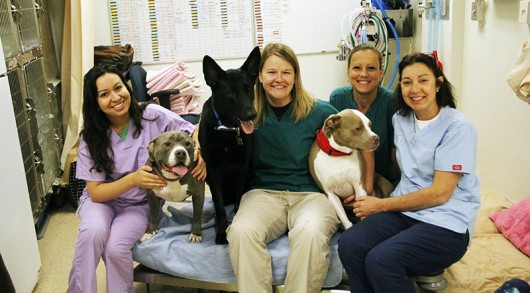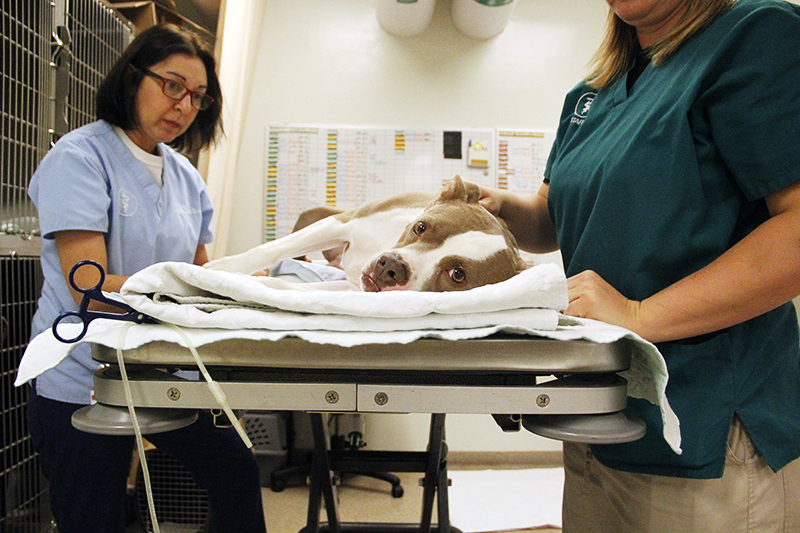
Workers at the Hospital of Companion Animals and some of the dogs who gave blood pose for a picture on Sept. 16. Credit: Francis Pellicciaro / Asst. Multimedia Editor
A greyhound walks along the tiled floor of a veterinary hospital, a place he often visits, without barking.
A veterinarian takes the animal into a room and places him on the hospital bed, where a needle is slipped into the dog’s neck.
This dog is Dorian, and he is at the Hospital for Companion Animals at Ohio State donating blood.
Dorian, who is now 5 years old, became a blood donor to the Ohio State University Animal Blood Bank more than two years ago, and will be able to donate until he is 7 to 8 years old.
OSU’s animal blood bank collects dog and cat blood, 80 percent of which is processed in-state and later shipped out to medical facilities outside of Ohio.
The number of emergency pet clinics has grown across the country. “So, every year the demand (for) blood is bigger,” said Dr. Cristina Iazbik, managing director of the OSU Animal Blood Bank.
This increased demand has led to a shortage of blood, and Iazbik said she hopes to bring the number of OSU donor dogs up from 85 to 100 or more.
“We are not (a) commercial blood bank. However, we supply as one of them,” Iazbik said.
Blood donation does not have any significant side-effects on dogs. Blood pressure goes down immediately after the donation, but fainting after donating blood is not seen in dogs, Iazbik said.
Iazbik added that donor dogs need to be comfortable in a hospital setting and are not aggressive toward other dogs and that, unlike cats, dogs are not sedated when donating blood.
“If it’s too much for the dog or the dog is too fearful to come to the hospital, it’s not a good thing for that dog,” Iazbik said. “The first time, some of them will be a little more uneasy or move at one point during the donation.”

Vinny, a pitbull, is prep’d to give blood on Sept. 16 at the Hospital of Companion Animals. Credit: Francis Pellicciaro / Asst. Multimedia Editor
Iazbik said greyhounds like Dorian are the ideal breed for giving blood because many have a blood type universally accepted among dogs, long necks to draw blood from and typically a larger red blood-cell count than the average dog breed.
But they are not the only kind of dog that can donate. Iazbik said large dogs in the Columbus area that are between 1 and 5 years old, 55 pounds or larger and healthy are welcome be screened.
German shepherds, pitbulls, boxers and labrador retrievers are accepted dog breeds.
“Right now, we have 15 pitbulls working with our program and they are the best,” Iazbik said.
Some OSU students were surprised to hear about the animal blood bank.
“I (have) never even heard of that,” said Sydney Zernechel, a third-year in hospitality management.
Zernechel said that Coda, her 9-month-old rottweiler, might be able to stay still on a donation bed if he was offered some peanut butter.
Currently, more than half of the donor dogs belong to OSU students and people working at the university, said Iazbik.
Tamra Mathie, a clinical trials technician at the hospital, owns four dogs and one cat that regularly donate blood. Her pitbull donated to a dog that needed a blood transfusion and the recipient was able to return home the next day.
Mathie said that sometimes when Iazbik calls her about bringing in one of her dogs to donate blood, she can go in an hour’s notice.
“After they donate, they don’t really care,” said Iazbik. “They eat and they take naps all day long.”


